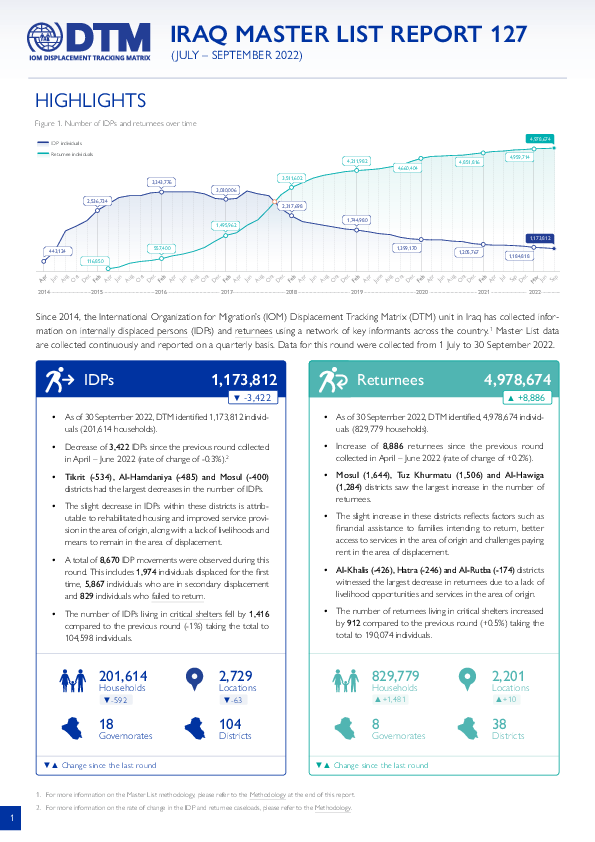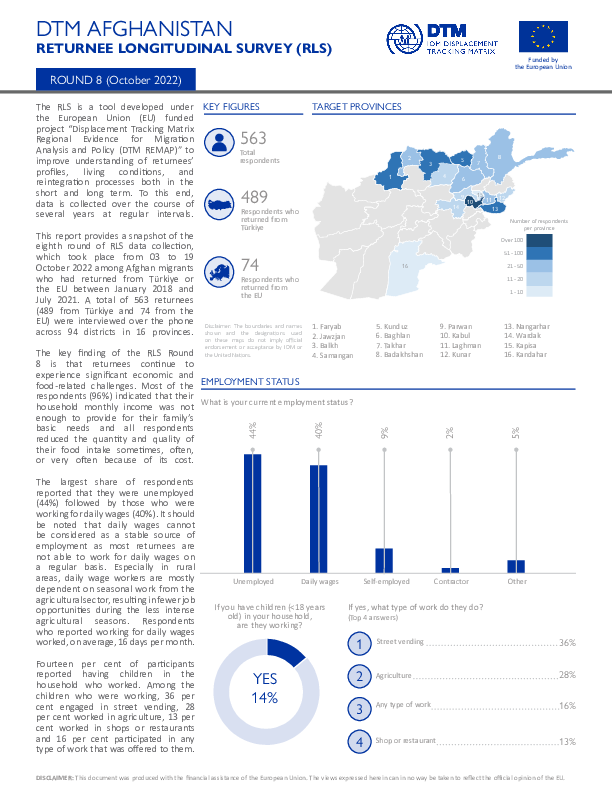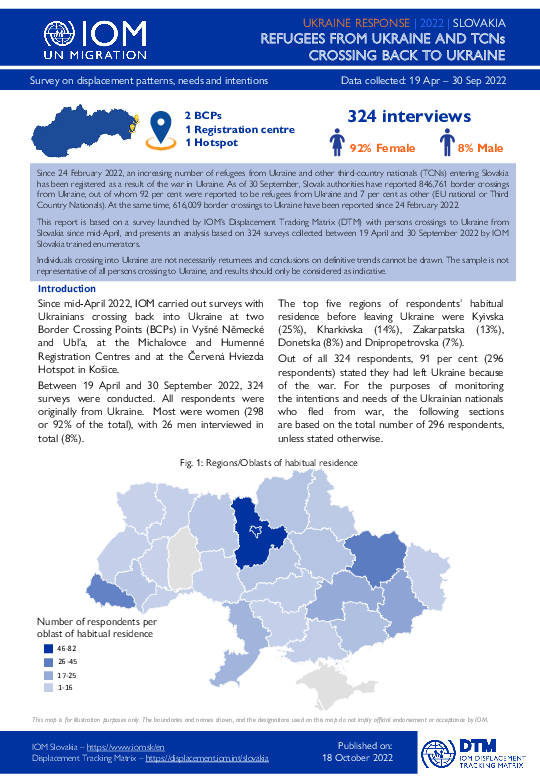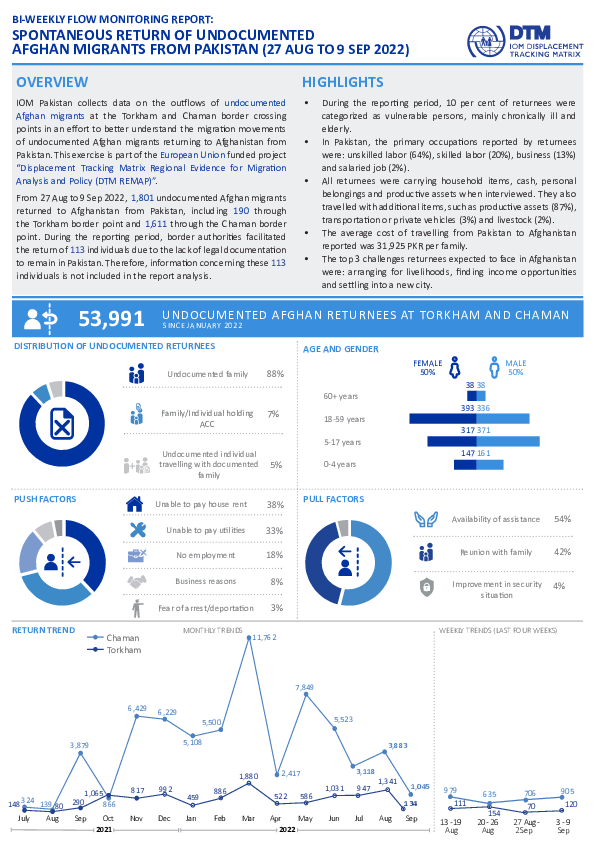-
Countries
-
Data and Analysis
-
Special Focus
-
Crisis Responses
Return migration

Contact
DTM Iraq, IraqDTM@iom.int
Language
English
Location
Iraq
Period Covered
Apr 01 2022
Jun 30 2022
Activity
- Survey
- Mobility Tracking
- Baseline Assessment
This report provides a detailed overview of the conditions faced by internally displaced persons (IDP) and returnee families residing in informal sites at the time of data collection of the Integrated Location Assessment 7 (ILA 7, April–June 2022). The ILA informal sites assessment was conducted in two parts. First, the location, population and shelter type of all informal sites were collected nationwide. Second, if the informal site had 15 or more families, a full assessment of the location was conducted, designed in partnership with the Cluster members of the Inter-Cluster Coordination Group (ICCG). In this report, data attributed to ‘fully assessed sites’ refer only to sites with 15 or more families.
The report concludes that families residing in informal sites face significant economic challenges impacting their ability to meet basic needs. Greater assistance and livelihoods programming are thus critical to support these groups. Additionally, the concerns surrounding water quality and waste collection highlighted in this assessment call for increased water, sanitation and hygiene (WASH) programming in informal sites. Despite the challenges of living in these sites, most families intend to remain in the short term and remain undecided about their intentions in the long term, which points to a need for greater durable solutions programming. More broadly, further assessments and monitoring of informal sites should be conducted to better understand conditions and emerging trends.

Contact
DTM Iraq, IraqDTM@iom.int
Language
English
Location
Iraq
Period Covered
Jul 01 2022
Sep 30 2022
Activity
- Mobility Tracking
- Baseline Assessment
Since 2014, the International Organization for Migration’s (IOM) Displacement Tracking Matrix (DTM) unit in Iraq has collected information on internally displaced persons (IDPs) and returnees using a network of key informants across the country.1 Master List data are collected continuously and reported on a quarterly basis. Data for this round were collected from 1 July to 30 September 2022.

Contact
DTMUkraine@iom.int
Language
English
Location
Ukraine
Period Covered
Oct 17 2022
Oct 27 2022
Activity
- Survey
Starting on 24 February 2022, a large-scale armed conflict in Ukraine triggered an unprecedented humanitarian crisis across the country, characterised, among other elements, by the displacement of a significant proportion of the Ukrainian population.
As early as April 2022, the International Organization for Migration (IOM) began observing significant return movements. Conditions of return vary widely, as returnees arrive back to areas not directly affected by the war, but which have experienced a significant influx of internally displaced persons (IDPs), as well as to conflict-affected and recently de-occupied areas which have sustained severe damage. Due to the volatility of the current situation, it is impossible to determine what proportion of the returns observed at present are permanent or temporary. Existing data shows, however, that the returnee population in Ukraine is characterized by a unique set of needs and vulnerabilities which set it apart from those who had never been displaced and from the population of IDPs.
To support partners in providing targeted, evidence-based assistance to those returning to their areas of habitual residence following a period of forced displacement, IOM presents the Ukraine Returns Report. This publication will strive to analyze IOM’s latest data on the situation and needs of the returnee population and on the conditions of return, collected through the Displacement Tracking Matrix (DTM) assessments conducted in the country.
This October 2022 edition of the Ukraine Returns Report presents a detailed analysis of data collected through the ninth round of IOM’s General Population Survey (GPS), conducted between 17 and 27 October among the adult population in Ukraine. The geographical scope of the assessment covers the entire territory of Ukraine, all five macro-regions (West, East, North, Centre, South, and the city of Kyiv), with the exception of the Crimean peninsula and the non-government-controlled-areas of Ukraine (NGCA). The general population survey was conducted using a random‐digit‐dial (RDD) approach, and 2,002 unique and anonymous respondents aged 18 and over were interviewed using the computer-assisted telephone interview (CATI) method.

Contact
DTM Afghanistan, DTMAfghanistan@iom.int
Language
English
Location
Afghanistan
Period Covered
Oct 03 2022
Oct 19 2022
Activity
- Survey
To better understand the demographic profiles, living conditions and reintegration processes of Afghan returnees, IOM, under the EU-funded project “Displacement Tracking Matrix Regional Evidence for Migration Analysis and Policy (DTM REMAP)”, developed the Returnee Longitudinal Survey (RLS).
This report provides a snapshot of the eighth round of RLS data collection, which took place from 03 October to 19 October 2022 among Afghan migrants who had returned from Türkiye or the EU between January 2018 and July 2021. A total of 563 returnees (489 from Türkiye and 74 from the EU) were interviewed over the phone across 94 districts in 16 provinces.
Starting on 24 February 2022, the war in Ukraine triggered an unprecedented humanitarian crisis and generated large scale displacement both within Ukraine and into the neighbouring countries. As of the end of September, 6.2 million persons were internally displaced in Ukraine1 and 7.4 million refugees from Ukraine were recorded in Europe.2 According to available administrative data, more than 13 million border crossings of refugees and Third-Country Nationals (TCNs) not in need of international protection from Ukraine were reported into the neighbouring countries since February 2022. At the same time, around 6 million were estimated to have returned including both from other locations within Ukraine and self-reported from abroad,3 and about 6 million cross-border movements were registered from Poland, Romania, Slovakia, and the Republic of Moldova among the neighbouring countries into Ukraine as of mid-September.
Since mid-April, IOM has deployed its Displacement Tracking Matrix (DTM) tools to collect individual surveys in neighbouring countries with persons crossing into Ukraine, with the aim to improve the understanding of main profiles, displacement patterns, intentions and needs.
This report is based on 9,495 valid surveys collected by IOM’s DTM in five European countries neighbouring Ukraine with adult refugees from Ukraine and TCNs crossing to Ukraine between 01 June and 15 September 2022: 3,519 in Romania, 3,151 in Poland, 2,418 in the Republic of Moldova, 259 in Hungary and 148 in Slovakia. Total results were weighted as per the number of border crossings into Ukraine reported in each country of the survey during the aforementioned period.
Movements can be pendular, and do not necessarily indicate sustainable returns as the situation across the country remains highly volatile and unpredictable. Hence, individuals surveyed while crossing into Ukraine from neighbouring countries are not necessarily returnees, and conclusions on definitive trends cannot be drawn.

Contact
DTM Europe, DTMMediterranean@iom.int
Language
English
Location
Slovakia
Period Covered
Apr 19 2022
Sep 30 2022
Activity
- Survey
Since 24 February 2022, an increasing number of refugees from Ukraine and other third-country nationals (TCNs) entering Slovakia has been registered as a result of the war in Ukraine. As of 30 September, Slovak authorities have reported 846,761 border crossings from Ukraine, out of whom 92 per cent were reported to be refugees from Ukraine and 7 per cent as other (EU national or Third Country Nationals). At the same time, 616,009 border crossings to Ukraine have been reported since 24 February 2022.
This report is based on a survey launched by IOM’s Displacement Tracking Matrix (DTM) with persons crossings to Ukraine from Slovakia since mid-April, and presents an analysis based on 324 surveys collected between 19 April and 30 September 2022 by IOM Slovakia trained enumerators.
Individuals crossing into Ukraine are not necessarily returnees and conclusions on definitive trends cannot be drawn. The sample is not representative of all persons crossing to Ukraine, and results should only be considered as indicative.

Contact
DTMUkraine@iom.int
Language
English
Location
Ukraine
Period Covered
Sep 17 2022
Sep 26 2022
Activity
- Survey
Starting on 24 February 2022, a large-scale armed conflict in Ukraine triggered an unprecedented humanitarian crisis across the
country, characterised, among other elements, by the displacement of a significant proportion of the Ukrainian population.
As early as April 2022, the International Organization for Migration (IOM) began observing significant return movements. Conditions of return vary widely, as returnees arrive back to areas not directly affected by the war, but which have experienced a significant influx of internally displaced persons (IDPs), as well as to conflict-affected and recently de-occupied areas which have sustained severe damage. Due to the volatility of the current situation, it is impossible to determine what proportion of the returns observed at present are permanent or temporary. Existing data shows, however, that the returnee population in Ukraine is characterized by a unique set of needs and vulnerabilities which set it apart from those who had never been displaced and from the population of IDPs.
To support partners in providing targeted, evidence-based assistance to those returning to their areas of habitual residence following a period of forced displacement, IOM presents the Ukraine Returns Report. This publication will strive to analyze IOM’s latest data on the situation and needs of the returnee population and on the conditions of return, collected through the Displacement Tracking Matrix (DTM) assessments conducted in the country.
This September 2022 edition of the Ukraine Returns Report presents a detailed analysis of data collected through the ninth round of IOM’s General Population Survey (GPS), conducted between 17 and 26 September among the adult population in Ukraine. The geographical scope of the assessment covers the entire territory of Ukraine, all five macro-regions (West, East, North, Centre, South, and the city of Kyiv), with the exception of the Crimean peninsula and the non-government-controlled-areas of Ukraine (NGCA). The general population survey was conducted using a random‐digit‐dial (RDD) approach, and 2,002 unique and anonymous respondents aged 18 and over were interviewed using the computer-assisted telephone interview (CATI) method.

Contact
DTMMediterrean@iom.int
Language
English
Location
Romania
Period Covered
May 04 2022
Sep 12 2022
Activity
- Survey
Starting on 24 February 2022, the war in Ukraine triggered an unprecedented humanitarian crisis and generated large scale displacement both within Ukraine and to the neighbouring countries. As of 9 September 2022, almost 7 million persons were internally displaced in Ukraine1 and over 12.5 million crossings of refugees and other Third-Country-Nationals (TCNs) not in need of international protection from Ukraine into the neighbouring countries were reported.2 However, an increasing number crossings back into Ukraine, with UNHCR reporting over 5.7 million crossings from neighbouring countries into Ukraine as of 13 September 2022.

Contact
DTM Pakistan, iomisbdtmremapteam@iom.int
Language
English
Location
Pakistan
Period Covered
Aug 27 2022
Sep 09 2022
Activity
- Flow Monitoring
IOM Pakistan collects data on the outflows of undocumented Afghan migrants at the Torkham and Chaman border crossing points in an effort to better understand the migration movements of undocumented Afghan migrants returning to Afghanistan from Pakistan. This exercise is part of the European Union funded project “Displacement Tracking Matrix Regional Evidence for Migration Analysis and Policy (DTM REMAP)”.
From 27 Aug to 9 Sep 2022, 1,801 undocumented Afghan migrants returned to Afghanistan from Pakistan, including 190 through the Torkham border point and 1,611 through the Chaman border point. During the reporting period, border authorities facilitated the return of 113 individuals due to the lack of legal documentation to remain in Pakistan. Therefore, information concerning these 113 individuals is not included in the report analysis.

Contact
DTM Afghanistan, DTMAfghanistan@iom.int
Language
English
Location
Afghanistan
Period Covered
Aug 20 2022
Sep 03 2022
Activity
- Survey
To better understand the demographic profiles, living conditions and reintegration processes of Afghan returnees, IOM, under the EU-funded project “Displacement Tracking Matrix Regional Evidence for Migration Analysis and Policy (DTM REMAP)”, developed the Returnee Longitudinal Survey (RLS).
This report provides a snapshot of the seventh round of RLS data collection, which took place from 20 August to 3 September 2022 among Afghan migrants who had returned from Türkiye or the EU between January 2018 and July 2021. A total of 575 returnees (499 from Türkiye and 76 from the EU) were interviewed over the phone across 94 districts in 16 provinces.
Pagination
- Previous page
- Page 9
- Next page

